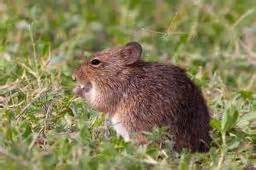by Don Happ
Most of us are not fans of rats. When we see one, we run in the opposite direction and begin setting out traps. But did you know that rats play an important role in the balance of nature? Did you know that some of them are native Texans? Allow me to introduce you to one of these natives.
There are twenty-plus species of native rats and mice in Texas. In grassy fields, you might see Norway rats (Rattus norvegicus), but more than likely you will see native hispid cotton rats (Sigmodon hispidus). ”Hispid” means covered with stiff or rough hair. The hispid rat’s hair color is a mixture of black, brown, and grey. Other physical characteristics include a round nose and round ears that resemble those of Mickey Mouse.
Hispid cotton rats are recyclers. Rather than dig new, extensive tunnels, they will use burrows built by other animals. Some live under man made structures. They mostly eat native vegetation, but they will also eat insects and small animals.
Hispid rats become an agricultural problem if their population explodes. An adult female may breed throughout the year in Texas when conditions are favorable. She may produce as many as nine litters of up to ten young each. Females can become mothers at the tender age of 68 days and grandmothers at 136 days. If we assume a new generation of cotton rats every 68 days, a female could be a great-great-great-grandmother at the age of one year and be the ancestor of about 15,500 cotton rats. If this same rate of reproduction were extended for only three more generations and all survived, the grand total of offspring from the original female would be more than 3-1/2 million! The population, however, is usually not dense. The reason for this is limited food, disease, and predators such as coyotes, hawks, owls, bobcats, and certain snakes.
If you happen to see a rat in a field, don’t panic and run. Just enjoy observing it and its place in nature. Remember, it is a native Texan. It was here to greet the first people who arrived in North America.
Do you think nature should be part of our everyday life, not just somewhere to go on the weekends? You are invited to attend our free, open-to-the-public, monthly program on the fourth Monday of the month at 7 pm at the First United Methodist Church, 505 W. Marvin Ave., Waxahachie, Texas 75165. For more information on the Indian Trail Master Naturalist Chapter, contact the Texas A&M AgriLife Extension Service at 972-825-5175 or visit our website: http://txmn.org/indiantrail/.


